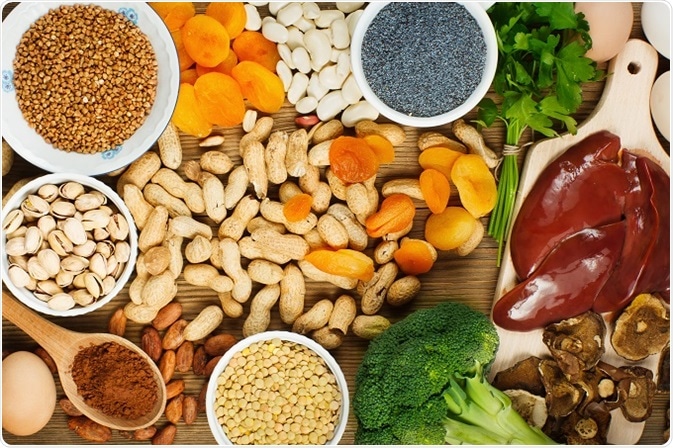Iron is a necessary mineral for the functioning of the body. It is estimated that around 20% of women, 3% of men, and 50% of pregnant women are iron deficient. Symptoms of iron deficiency include fatigue, pallor, and cravings for non-food items like ice or dirt.

©Evan Lorne / Shutterstock.com
Fortunately, it is abundant in many common food sources. Dietary iron is typically found in two forms. Heme iron is a form in which the iron ion is surrounded by a ring-shaped molecule called porphyrin. Iron is absorbed primarily in the small intestine.
People at Risk of Iron Deficiency
Some people are at a higher risk of being deficient in iron, including:
- Poor or homeless people
- People with an eating disorder
- Elderly people
- Children who drink a lot of cow’s milk
- People on a diet to lose weight
- People who don’t eat fruits, vegetables and meat
- People who consume a lot of caffeine
- People who take antacids
Heme Iron
Heme iron is found in animal-based foods. Some foods rich in heme iron are:
- Beef liver
- Chicken liver
- Clams
- Mussels
- Oysters
- Beef
- Canned sardines
- Turkey
- Chicken
- Halibut
- Haddock
- Perch
- Salmon
- Tuna
- Ham
- Veal
At the high end, beef liver offers 3.5 milligrams of heme iron per serving. Chicken has 0.7 milligrams of iron per serving.
Non-Heme Iron
Plant foods contain non-heme iron. Good sources of non-heme iron are:
- Enriched cereals
- Cooked beans
- Tofu
- Pumpkin seeds
- Canned lima beans
- Dried apricots
- Baked potato
- Broccoli
- Nuts (peanuts, pecans, walnuts, pistachios, etc.)
- Raisins
- Spinach
- Rice
People with iron deficiency anemia should consume at least three 4-ounce portions of red meat each week. After the iron balance is restored, an adequate daily intake of protein should be continued, while reducing or eliminating refined sugar.
Improving Iron Absorption
The body’s absorption of iron can be increased or decreased by the presence of other nutrients consumed with it. It is important to get enough vitamin C (ascorbic acid) to aid absorption of iron. Many fruits and vegetables are high in vitamin C.
On the other hand, coffee, tea, and calcium-rich foods can block absorption of iron. If your iron levels are low, such items should be consumed at least two hours before or after iron-containing foods.
Vegetarians
Non-heme iron is not absorbed as well by the body as heme iron, so vegetarians tend not to store as much iron in their bodies as people who eat meat. Again, phytates, which are present in whole grains and legumes - the staples of a vegetarian diet - can block iron absorption.
Vegetarians need to pay particular attention to combining foods rich in iron with vitamin C to enhance absorption. People who don’t eat meat may need twice as much iron per day as those who eat meat.
Supplements
Some people may need to take an iron supplement on a regular basis in order to maintain iron levels in the body. A daily multivitamin that contains iron should be adequate for most people. Taking a separate iron supplement can have harmful side effects, and should only be done under a physician’s supervision.
Further Reading
Last Updated: Jan 2, 2023